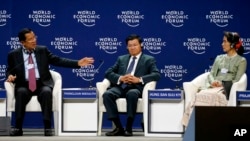Leaders of the Mekong nations have raised concerns over the development of hydropower along the river system following the collapse of a major dam in Laos in July.
The leaders met on Wednesday at the World Economic Forum on Asean to discuss their vision for the region’s development, which was live streamed.
The Lower Mekong Basin is home to some 60 million people and has a gross domestic product of about $800 billion, according to official figures. About 40 percent of the population lives within a 15-kilometer-wide corridor along the river banks and depend on the river to support four-fifths of their food and other livelihood needs, according to the Mekong River Commission.
Aung San Suu Kyi, Myanmar’s state councilor, said the Mekong nations must work together to solve the problems plaguing the region.
“There are a lot of things involved: competition, cooperation, complementary, common challenges, and climate change. These are all the things that we are facing now. I think these give us a very, very good chance to cooperate,” she said.
Thongloun Sisoulith, the Laotian prime minister, said Laos had the capacity to “leverage this potential in terms of water resources” and could “produce electricity that is sufficient for Laos and can be exported to our neighboring countries.”
Some 7,000 people were forced to flee the Atapeu dam collapse in July, which left several dead.
Suu Kyi said Myanmar was considering delaying the import of electricity from Laos.
“We were thinking of buying electricity from Laos, but we have been warned that perhaps we shouldn’t rush into this,” she said.
Myanmar and Laos signed the MOU on power cooperation in January 2018.
“Building hydropower dam projects in Laos should be done based on a well-studied and well-planned approach,” said Laos’ Sisoulith. We have to ensure that we comply with international standards. The study of the project should be based on scientific information and expert views,” he added.







